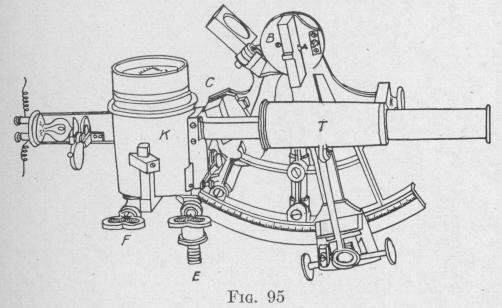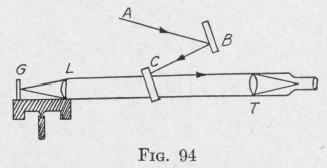120 THE GYROSCOPIC PENDULUM
When the light after reflection from the two mirrors coincides with the axis of the telescope, the angle
GBV = VBT = z GBT
Whence, the angle NGB = GBV
Consequently, NG and BV are parallel, and the two mirrors are parallel. Since the spin-axis NG of the top is practically vertical, the two mirrors are practically horizontal.
From the construction of the divided circle, the line BO from the pivot to the zero line is perpendicular to A T and A'G. And since BV is perpendicular to the horizontal HG, it follows that the altitude of the star A'GH = OBV.
76. The Fleuriais Gyroscopic Octant. - This is an octant (or a sextant) to which is attached a top with a flat surface normal
to the spin-axis and with the center of mass below the peg.
The recent models carry on
the flat surface, Fig. 94, a con
verging lens L and a piece of
plane clear glass G perpendicu
lar to the plane of the diagram.
One face of this glass is ruled with a series of parallel horizontal lines. The ruled face is in the focal plane of the lens. Light from the ruled lines, after traversing the-lens L, the fixed halfsilvered mirror C and the objective lens of the telescope T, forms an image of the rulings in the focal plane of the eye-lens. In the focal plane of the eye-lens there is a cross hair perpendicular to the plane of the frame of the instrument, that is, the cross hair is nearly horizontal. When the plane of the frame of the instrument and the axis of the top are vertical, light from the middle ruling traverses the axis of the telescope and the image of this ruling coincides with the cross hair. The axis of the telescope is now horizontal.
An eye of an observer at the eye-lens of the telescope perceives the image of the rulings every time light from the rulings proceeds along the axis of the telescope. The image is produced once during each revolution of the top. The impression of an image on the human retina persists for about one-tenth of a second after the cessation of the exciting cause, the duration depending upon the brightness of the light. Consequently, if the top be rotated at a sufficiently high speed, the image will appear to be continuous.
GYRO-HORIZONTALS AND GYRO-VERTICALS 121
The top is enclosed in an air-tight case K, Fig. 95, provided with a pair of windows in line with the axis of the telescope. When the instrument is used during the daytime the ruled glass plate is illumined by daylight entering the window farthest from the telescope. When used at night, the ruled plate is illumined by a tiny incandescent lamp operated by a pocket dry battery.
The required high spin-velocity is produced by a current of air blowing against a row of blades around the periphery of the top. A hand-operated exhaust pump is connected to a tube E and the case is evacuated to a pressure of from six to eight centimeters of mercury. The pressure is indicated by an aneroid barometer on
top of the case. On now opening the stop-cock F, air rushes into the case and against the blades on the periphery of the top. The top quickly attains a speed of more than 7000 revolutions per minute. The stop-cock F is again closed and the pump operated till the pressure is again reduced to about six centimeters of mercury, the stop-cock E is closed and the pump detached. The top will continue to rotate in the vacuous space for several minutes without the spin-velocity diminishing as much as 25 per cent. This time is long enough to take the required observation.
If the spinning wheel rested on a sharp point, there would be a small angle between the spin-axis and the vertical that could be computed from (86). In the actual instrument, however, this angle is reduced to a negligible value by rounding off the peg that supports the spinning wheel (Art. 45).
77. The Sperry Roll and Pitch Recorder. - This instrument is used to record the angles of roll and of pitch of a ship in a seaway,

